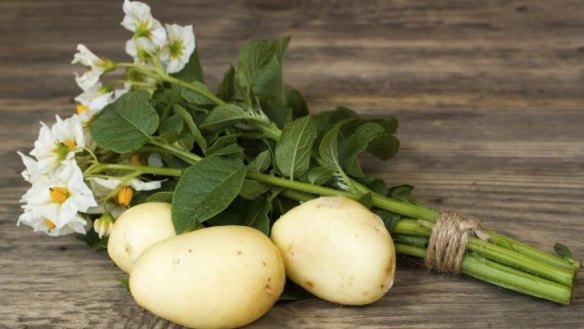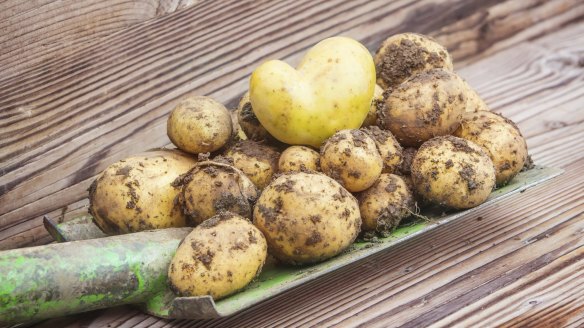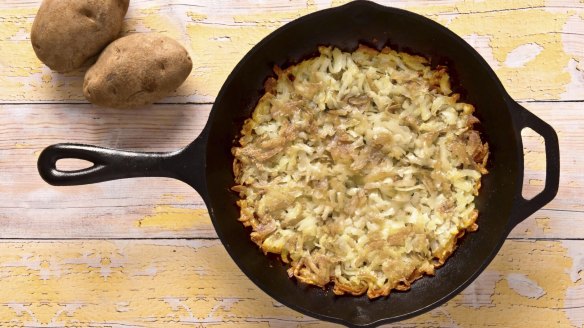Owen Pidgeon: How to grow the best potatoes in Canberra region

When you ask yourself what are the vegetables you can plant and grow with children afoot, the answer might often be: "something big and easy to plant". Potatoes lend themselves very much to involvement with children. You might just need to think of another vegetable with big-sized seeds and quick-growing potential, to keep them interested as the potato pushes its shoots upward towards the light.
This temperate climate vegetable is so important to nutrition in human history. Varieties have been grown in Peru and Chile for at least 7000 years. Potatoes join with wheat, maize and rice as a nutritious starchy staple.
There are eight species with close to 3000 varieties being still grown in the high mountain areas of the Andes. You can just imagine the colours, the hues and shapes at any market place in Peru, Ecuador, Bolivia or Chile today.
This fine vegetable was taken to Europe in the late 16th century by the Spaniards and by Sir Francis Drake, but it stayed a "curiosity" vegetable for nearly 100 years.
We can thank the French scientist, Antoine Parmentier for completing a thesis in the 1770s on the food benefits of potatoes, after he had spent time as a prisoner of war in Prussia and had survived on a diet of potatoes. Today we have many fine Dutch, Belgium and German varieties available here in Australia.
Potatoes flourish in deep, fertile, well drained soil. They like lots of sunshine. However, the shoots and leaves are frost sensitive so you really cannot safely plant out potatoes in highland regions much before the end of the frost season. If you have chitted your potatoes in a partially lit location to produce some good, strong shoots, you should see the leaves emerging within two weeks from planting.
For me, the easiest way of planting potatoes is to firstly dig in plenty of high humus organic matter, such as well finished compost then dig shallow trenches along the garden bed. Add in some blood and bone and old sheep manure then rake a little soil over the prepared bed.

Dig your trench north-south if possible to allow your plants to have sunlight on both sides. Just excavate to a depth of 10 centimetres and plant your seed potatoes with the shoots pointing to the sky with spacing at 20 centimetres. Cover with some soil carefully, to avoid damaging the shoots. When the shoots emerge and the first leaves appear, begin earthing up of the rows of potatoes, on both sides. This will provide more cover for the new potatoes and prevent exposure to light which will turn your potatoes green and make them inedible.
Potatoes are relatively slow growing with the harvest coming four to five months after planting (although you can always take your young helpers on a bandicoot expedition). You may know that the bandicoot is a small omnivorous marsupial with a pointy snout that loves to dig for insects, earthworms and root tubers.
So the expression of going bandicooting in your potato patch is all about gently digging into the soil to find some of the small, partially grown potatoes for a special treat. You are sacrificing some of the final crop but it allows you to enjoy the "first fruits" weeks ahead of the final harvest.
In planning your crops, remember that a later planting of potatoes (in late November to early December) will typically produce the highest yields, for later consumption next autumn and winter. This later crop is the one you will store.
With reasonably good soil and regular waterings over summer, you should be able to produce seven to eight kilograms of potatoes from every kilogram that you plant. Top growers can achieve an output of 1:10, so there is a little challenge for you.
Potatoes can be kept in the ground for a long time after they have matured and the foliage has died off. The tubers will harden off, compared to the thin skins of "new season" potatoes. Robinson Gourmet Potatoes in the Southern Highlands and Ingelara Farm at Bredbo are two local, regional potato growers that harvest weekly a small part of their crops right through the winter months, so restaurants and farmers' market customers can have fresh product. Provided you have your potatoes growing in well drained soil, you too can leave them underground until you are ready to cook with them.
The two main groupings of potatoes have quite distinct uses. Floury ones are better for baking, frying and roasting. Waxy potatoes have a lower ratio of starch and have a higher moisture content, so are best used in salads, casseroles and soups.
King Edward and Otway Red are two good mashing and roasting potatoes. Good mashing potatoes include three Australian-bred potatoes, namely Toolangi Delight with its purple skin, Purple Congo which is coloured throughout and the cream-coloured Eureka.
Kennebec, Dutch Cream, Bintje, Nicola and Kipfler are waxy, yellow flesh potatoes of distinction. Ruby Lou and Salad Rose are both excellent pink-coloured potatoes that can be used in salads. Nicola is one of the best potatoes to use when making gnocchi.
If in mid October you have been successful in getting your potato crop well established but a cold frosty night is forecast, cover the tender leaves with straw, a length of cardboard sheeting or hessian.

Swiss potato rosti
800g waxy potatoes
1 large onion
100g diced bacon
30g butter
olive oil
salt and black pepper
Scrub the potatoes well and boil in water until slightly soft. Drain and cool. Peel off the skin and then grate the potatoes with a coarse grater.
Take a shallow, heavy duty pan and melt the butter then saute the onion and bacon. Mix in the grated potatoes and season with salt and pepper. Form into a large potato cake and cook over high heat. When the potato has browned underneath, invert a plate over the pan and turn the rosti onto the plate. Then slide the overturned potato cake back into the pan to brown the second side.
This week in the garden
* Plant basil and oregano seeds into planter boxes. Plant out a row or two of silverbeet, spinach, radish and mixed lettuce directly into the garden.
* Transplant your little tomato seedlings when they have two sets of leaves or more out of the propagation trays into small pots. Keep in a warm protected location through October.
* Plant cucumber and zucchini seeds into punnets, in preparation for planting out in mid October.
* Aim to spend 10-15 minutes each day to hoe and chisel out weeds that are growing so rapidly. Then apply a generous mulch to your garden bed that have been established.
* Thin your stone fruit trees, if you have achieved a big set of fruit.
Owen Pidgeon runs the Loriendale Organic Orchard near Hall.
Restaurant reviews, news and the hottest openings served to your inbox.
Sign up